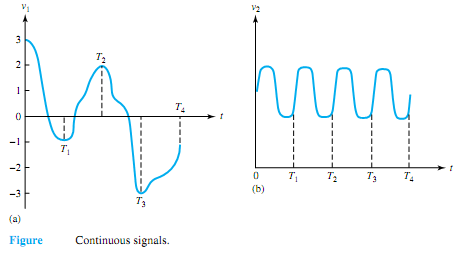Q. What do you mean by Digital Building Blocks?
Whereas a continuous change from one value to another is the essential characteristic of an analog signal and continuous-state (analog) circuits are used to process analog signals, signals represented by discrete amplitudes at discrete times are handled by discrete-state (digital) circuits.
Analog systems process the information contained in the time function, which defines the signal, whereas digital systems, as the name implies, process digits, i.e., pulse trains, in which the information is carried in the pulse sequence rather than the amplitude-time characterization of the pulses. Figure illustrates continuous signals, whereas Figure depicts discrete signals. Consider Figure (a) to be a voltage signal (as a function of a continuous-time variable t) representing a physical quantity, such as the output voltage of a phonograph cartridge. The discrete signal (which exists only at specific instances of time) of Figure (a) has the same amplitude at times t = 0, T1, T2, and T3 as does the continuous signal of Figure (a). Figure 6.0.2(a) represents the sampled-data signal obtained by sampling the continuous signal at periodic intervals of time. The sequence of pulses in each time interval in Figure (b) is a numeric, or digital, representation of the corresponding voltage samples shown in Figure (a). Figure (b) may be considered as the signal, called a clock, which sets the timing sequence used in the generation of the pulses shown in Figure. An analog signal is an electric signal whose value varies in analogy with a physical quantity such as temperature, force, or acceleration. Sampling of an analog signalmakes it discrete in time.
A digital signal, on the other hand, can only have a finite number of discrete amplitudes at any given time. Through a process known as quantization, which consists of rounding exact sample

values to the nearest of a set of discrete amplitudes called quantum levels, a digitized signal can be obtained as discussed in more detail in Section.